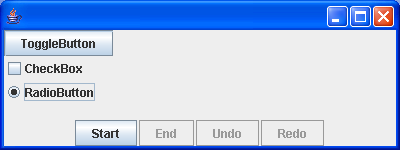The use of StateEdit(able)

/*
Java Swing, 2nd Edition
By Marc Loy, Robert Eckstein, Dave Wood, James Elliott, Brian Cole
ISBN: 0-596-00408-7
Publisher: O'Reilly
*/
// UndoableToggleApp4.java
//A sample app showing the use of StateEdit(able).
//
import java.awt.BorderLayout;
import java.awt.Container;
import java.awt.event.ActionEvent;
import java.awt.event.ActionListener;
import java.util.Hashtable;
import javax.swing.Box;
import javax.swing.BoxLayout;
import javax.swing.JButton;
import javax.swing.JCheckBox;
import javax.swing.JFrame;
import javax.swing.JRadioButton;
import javax.swing.JToggleButton;
import javax.swing.undo.CannotRedoException;
import javax.swing.undo.CannotUndoException;
import javax.swing.undo.StateEdit;
import javax.swing.undo.StateEditable;
public class UndoableToggleApp4 extends JFrame implements StateEditable {
private JToggleButton tog;
private JCheckBox cb;
private JRadioButton radio;
private JButton undoButton;
private JButton redoButton;
private JButton startButton;
private JButton endButton;
private StateEdit edit;
// Create the main frame and everything in it.
public UndoableToggleApp4() {
// Create some toggle buttons (and subclasses).
tog = new JToggleButton("ToggleButton");
cb = new JCheckBox("CheckBox");
radio = new JRadioButton("RadioButton");
// Add our listener to the buttons.
SimpleListener sl = new SimpleListener();
tog.addActionListener(sl);
cb.addActionListener(sl);
radio.addActionListener(sl);
// Lay out the buttons.
Box buttonBox = new Box(BoxLayout.Y_AXIS);
buttonBox.add(tog);
buttonBox.add(cb);
buttonBox.add(radio);
// Create undo, redo, start, and end buttons.
startButton = new JButton("Start");
endButton = new JButton("End");
undoButton = new JButton("Undo");
redoButton = new JButton("Redo");
startButton.setEnabled(true);
endButton.setEnabled(false);
undoButton.setEnabled(false);
redoButton.setEnabled(false);
// Add a listener to the start button. It creates a new StateEdit,
// passing in this frame as the StateEditable.
startButton.addActionListener(new ActionListener() {
public void actionPerformed(ActionEvent ev) {
edit = new StateEdit(UndoableToggleApp4.this);
startButton.setEnabled(false);
endButton.setEnabled(true);
//undoButton.setEnabled(edit.canUndo());
//
// NOTE: We really don't want to be able to undo until end() is
// pressed,
// but StateEdit does not enforce this for us!
undoButton.setEnabled(false);
redoButton.setEnabled(edit.canRedo());
}
});
// Add a listener to the end button. It will call end() on the
// StateEdit.
endButton.addActionListener(new ActionListener() {
public void actionPerformed(ActionEvent ev) {
edit.end();
startButton.setEnabled(true);
endButton.setEnabled(false);
undoButton.setEnabled(edit.canUndo());
redoButton.setEnabled(edit.canRedo());
}
});
// Add a listener to the undo button. It attempts to call undo() on the
// current edit, then enables/disables the undo/redo buttons as
// appropriate.
undoButton.addActionListener(new ActionListener() {
public void actionPerformed(ActionEvent ev) {
try {
edit.undo();
} catch (CannotUndoException ex) {
ex.printStackTrace();
} finally {
undoButton.setEnabled(edit.canUndo());
redoButton.setEnabled(edit.canRedo());
}
}
});
// Add a redo listener: just like the undo listener.
redoButton.addActionListener(new ActionListener() {
public void actionPerformed(ActionEvent ev) {
try {
edit.redo();
} catch (CannotRedoException ex) {
ex.printStackTrace();
} finally {
undoButton.setEnabled(edit.canUndo());
redoButton.setEnabled(edit.canRedo());
}
}
});
// Lay out the state/end and undo/redo buttons.
Box undoRedoBox = new Box(BoxLayout.X_AXIS);
undoRedoBox.add(Box.createGlue());
undoRedoBox.add(startButton);
undoRedoBox.add(Box.createHorizontalStrut(2));
undoRedoBox.add(endButton);
undoRedoBox.add(Box.createHorizontalStrut(2));
undoRedoBox.add(undoButton);
undoRedoBox.add(Box.createHorizontalStrut(2));
undoRedoBox.add(redoButton);
undoRedoBox.add(Box.createGlue());
// Lay out the main frame.
Container content = getContentPane();
content.setLayout(new BorderLayout());
content.add(buttonBox, BorderLayout.CENTER);
content.add(undoRedoBox, BorderLayout.SOUTH);
setSize(400, 150);
}
public class SimpleListener implements ActionListener {
// When any toggle button is clicked, we turn off the undo and redo
// buttons, reflecting the fact that we can only undo/redo the last
// set of state changes as long as no additional changes have been made.
public void actionPerformed(ActionEvent ev) {
undoButton.setEnabled(false);
redoButton.setEnabled(false);
}
}
// Save the state of the app by storing the current state of the three
// buttons. We'll use the buttons themselves as keys and their selected
// state as values.
public void storeState(Hashtable ht) {
ht.put(tog, new Boolean(tog.isSelected()));
ht.put(cb, new Boolean(cb.isSelected()));
ht.put(radio, new Boolean(radio.isSelected()));
}
// Restore state based on the values we saved when storeState() was called.
// Note that StateEdit discards any state info that did not change from
// between the start state and the end state, so we can't assume that the
// state for all 3 buttons is in the Hashtable.
public void restoreState(Hashtable ht) {
Boolean b1 = (Boolean) ht.get(tog);
if (b1 != null)
tog.setSelected(b1.booleanValue());
Boolean b2 = (Boolean) ht.get(cb);
if (b2 != null)
cb.setSelected(b2.booleanValue());
Boolean b3 = (Boolean) ht.get(radio);
if (b3 != null)
radio.setSelected(b3.booleanValue());
}
// Main program just creates the frame and displays it.
public static void main(String[] args) {
JFrame f = new UndoableToggleApp4();
f.setDefaultCloseOperation(JFrame.EXIT_ON_CLOSE);
f.setVisible(true);
}
}
Related examples in the same category